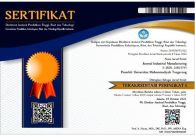Implementasi Line Balancing Untuk Meningkatkan Output Produksi Lini Assembly Loading Biscuit Di Industri Keramik Tangerang
Abstract
Advances in industrial technologies are growing rapidly, the Company is trying to make periodic improvements to maintain its competitiveness by selecting the correct working method, the Tangerang ceramic industry is an industry engaged in the manufacture of porcelain, in January-December 2021 the production output never reaches the given standard company. The purpose of this research is to find out the cause of the non-achievement of the production target in January-December 2021, find the root of the problem and provide improvements to the non-achievement of the production target. The method used in this study is Line Balancing to calculate the line efficiency value of the Tangerang ceramic industry and find bottleneck stations that result in not achieving production targets, in this study fishbone diagrams and 5why are also used as additional tools to find the root of the existing problems. The results of this study indicate that the production value on the biscuit loading assembly line is 77.56% with a bottleneck at the finishing station with a cycle time of 32.82sec, or a standard time of 36.102 sec exceeding the standard takt time given to achieve the target of 1,800 pcs/shift by Therefore, improvements were made by increasing the number of special finishing operators, replacing raw materials with better quality, re-setting the machine or upgrading some spare parts, every item to be dismantled has been prepared near decha. From the results of the improvement in production output from January to March 2022, it increased by 84.83%.
Keywords: Line Balancing, Porcelain, Bottle Neck, Fishbone Diagram, 5 Why, Line Efficiency, Calculation of Standard Time.
Full Text:
PDFReferences
Azwir, H. H. dan Pratomo, H. W. (2017). Implementasi Line Balancing untuk Peningkatan Efisiensi di Line Welding Studi Kasus: PT X. Jurnal Rekayasa Sistem Industri, Vol. 6 No. 1, 57-63.
Dharmayanti, I. dan Maarliansyah, H. (2019). Perhitungan Efektifias Lintas Produksi Menggunakan Metode Line Balancing. Jurnal Manajemen Industri dan Logistik. Vol. 03 No. 1, 43-54
Djunaidi. M. dan Angga. (2017). Analisis Keseimbangan Lintas pada Proses Perakitan Body Bus Pada Karoseri Guna Meningkatkan Efisiensi Lintasan. Jurnal Ilmiah Teknik Industri. Vol. 5 No. 2, 77-84
Gaspersz, Vincent, (1998). Manajemen Produksi Total, Strategi Peningkatan Produktivitas Bisnis Global, Gasperz Jakarta: Gramedia Pustaka Utama,
Iswardi, Sayuti, M. (2016). Analisis Prouktivitas Perawatan Mesin dengan Metode TPM (Total Productive Maintenance) Pada Mesin Mixing Section. Jurnal of Mechanical Science and Tecnology, Vol.4 No.2, 10-13
Kanal PU, (2021). Pengertian Efisiensi, Tujuan, Jenis Dan Contohnya. Penerbit: Kanal PU.
Kannan, V. K. and Anbumalar, V. (2015). Implementation of Line Balancing Method for Manufacturing Line of Handle bar. International Journal of Innovative Science, Engineering & Technology. Vol. 3 No. 6, 142-155
Komarudin, dan Saputra, R. (2012). Peningkatan Efisiensi dan Produktivitas Kinerja Melalui Pendekatan Analisis Rangked Positional Weight Method PT. X. Jurnal Teknik Industri. 1-8
Krisnaningsih, E. (2015). Usulan Penerapan TPM dalam Rangka Peningkatan Efektifitas Mein Dengan OEE Sebagai Alat Ukur di PT. XYZ. Jurnal PROSISKO, Vol.2 No.2, 13-26
Manaye, M. (2019). Line Balancing Techniques for Productivity Improvement. International Journal of Mechanical and Industrial Technology. Vol. 7 No. 1, 89-104
Mathew, J. Jose, P. and Silvan, G. (2016). Optimization of Cycle Time in an Assembly Line Balancing Problem. International Journal of Procedia Technology. Vol. 25, 1146-1153
Panudju, A. T., Panulisan, B. S., dan Fajriati, E. (2018). Analisis Penerapan Konsep Penyeimbangan Lini dengan Metode Ranked Position Weight Pada Sistem Produksi Penyamakan Kulit Di PT. Tong Hong Tannkery Indonesai Serang Banten. Jurnal Integrasi Sistim Produksi. Vol. 5 No. 2, 69-80
Parvez, M. Amin, F. B. Akter, F. (2017). Line Balancing Techniques to Improve Productivity Using Work Sharing Method. Journal of Research & Method in Education. Vol. 7 No. 3, 7-14
Prabowo, R. (2016). Penerapan Konsep Line Balancing Untuk Mencapai Efisiensi Kerja Yang Optimal Pada Setiap Stasiun Kerja Pada PT. HM. Sampoerna Tbk. Jurnal IPTEK. Vol. 20 No.2, 9-20.
Purnomo, H (2004). Pengantar Teknik Industri. Yogyakarta: Graha Ilmu Yogyakarta. Purnomo.
Rachman, T. (2013). Penggunaan Metode Work Sampling Untuk Menghitung Waktu Baku Dan Kapasitas Produksi Karungan Soap Chips Di PT.SA. Jurnal Inovasi. Vol.9, No.1, 48-60.
Sedarmayanti. (2018). Sumber Daya Manusia dan Produktivitas Kerja. Bandung: CV Mandar Maju. Sedarmayanti.
Shettigar, A. C. Hamirtha, S. and Balakrishna, A. (2019). Efficiency Improvement in the Assembly Line with the Application of Assembly Line Balancing Method. International Journal of Recent Technology and Engineering. Vol. 8, 848-853
Trenggonowati, D. L. dan Febriana, N. (2019). Mengukur Efisiensi Lintasan dan Stasiun Kerja Menggunakan Metode Line Balancing Study Kasus PT. XYZ. Jurnal Industrial Services. Vol. 4 No. 2, 97-105
Yanuar, A. A. Suryadhini, P. (2018). Perancangan Line Balancing Untuk Meminimasi Waste Waiting Pada Proses Produksi Modul Surya 260WP PT XYZ dengan Pendekatan Lean Manufacturing. E-Proceeding of Engineering. Vol. 5 No. 2, 2713-2710
DOI: http://dx.doi.org/10.31000/jim.v9i2.12446
Article Metrics
Abstract - 2478 PDF - 1772DOI (PDF): http://dx.doi.org/10.31000/jim.v9i2.12446.g5539
Refbacks
- There are currently no refbacks.













